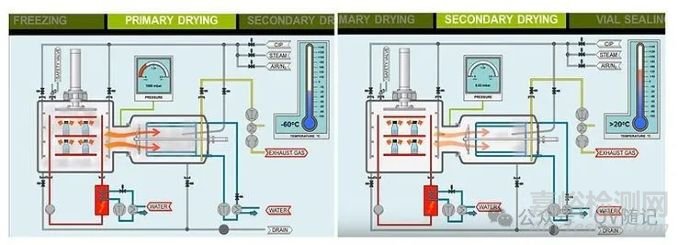您當(dāng)前的位置:檢測(cè)資訊 > 生產(chǎn)品管
嘉峪檢測(cè)網(wǎng) 2025-04-07 17:21
The lyophilized drugs in the pharmaceutical industry cannot afford to compromise on cleanliness. Lyophilizer contamination results in wasted effort and resources, or worse, creates health and safety issues that can compromise a company’s reputation and customer confidence.
制藥行業(yè)中的凍干藥物不能在清潔度上妥協(xié)。凍干機(jī)污染會(huì)導(dǎo)致精力和資源浪費(fèi),更糟的是,還會(huì)造成健康和安全問題,從而損害公司的聲譽(yù)和客戶信心 。
Detecting and quantifying trace residue concentrations of active pharmaceutical ingredients (API), excipients, and washes during lyophilizer cleaning validation procedures is one of the single largest costs associated with the manufacture of pharmaceutical freeze dried drugs.
在凍干機(jī)清潔驗(yàn)證程序中檢測(cè)和量化活性藥物成分( API )、賦形劑和清洗劑的痕量殘留濃度是與制藥凍干藥物生產(chǎn)相關(guān)的最大單項(xiàng)成本之一。
The lyophilizer cleaning validation is a very laborious process and combined with the idle time of the manufacturing equipment is a very expensive part of pharmaceutical manufacturing cost.
凍干機(jī)清潔驗(yàn)證是一個(gè)非常費(fèi)力的過程,加上生產(chǎn)設(shè)備的閑置時(shí)間,是藥品生產(chǎn)成本中非常昂貴的一部分。
The FDA clearly outlines its expectations within the lyophilizer cleaning validation under Inspections Guides. To satisfy the enumerated expectations, there can be many different approaches to cleaning verification and/or validation, based on the most efficient, cost-effective and practical approach.
FDA 在《檢查指南》中明確概述了其對(duì)凍干機(jī)清潔驗(yàn)證的期望。為了滿足所列舉的期望,基于最有效、最具成本效益和最實(shí)用的方法,可以有許多不同的清潔驗(yàn)證和/或確認(rèn)方法。
There are 3 kinds of surfaces in the Pharmaceutical Industry:
制藥行業(yè)中有 3 種類型的表面:
● 直接產(chǎn)品接觸:直接接觸制成品(或作為最終產(chǎn)品一部分的子產(chǎn)品),且極可能轉(zhuǎn)移殘留物和污染物。
Direct Product Contact: Directly contact manufactured product (or sub products that then are part of the final product) and for which there is a very high likelihood of transfer of residues and contaminants.
● 間接產(chǎn)品接觸:靠近敞口的產(chǎn)品,并且殘留物和污染物有很小或中等可能性轉(zhuǎn)移到產(chǎn)品中,通常通過載體(操作員、氣流)。
Indirect Product Contact: It is in close proximity to open product and where there is a remote or moderate likelihood of transfer of residues and contaminants to product, usually by a vector (Operator or Airflow).
● 非產(chǎn)品接觸:不直接接觸制成品,也不靠近敞口的產(chǎn)品。不可能轉(zhuǎn)移殘留物和污染物。
Non Product Contact: Does not directly contact manufactured product and is not in close proximity to open product. Is unfeasible the transfer of residues and contaminants.
1.風(fēng)險(xiǎn)分析(FMECA)
Risk Analysis (FMECA)
The lyophilizer has indirect product contact surfaces (see figure 1): Trays, where the vials are deposited for lyophilized (which allow their transfer and loading) and shelves (internal part of the equipment), which supports the trays:
凍干機(jī)具有間接產(chǎn)品接觸表面(見圖1):托盤、用于存放待凍干的小瓶(允許其轉(zhuǎn)移和裝載)和板層(設(shè)備的內(nèi)部部分),用于支撐托盤:

FIGURE 1 圖1
2.一些定義
Some definitions
Failure mode: the ways, or modes, in which something might fail. Failures are any errors or defects, especially ones that affect the customer, and can be potential or actual.
故障模式:某事物可能出現(xiàn)故障的方式或模式。故障是指任何錯(cuò)誤或缺陷,尤其是影響客戶的錯(cuò)誤或缺陷,可能是潛在的,也可能是實(shí)際的。
Potential failure mode: It is each possible failure mode without being necessary for the fault to actually occur. It usually answers questions such as: - In what way is it conceived, that the product or process could fail? - How could the component fail to meet specifications?
潛在故障模式:這是每種可能的故障模式,但故障不一定會(huì)發(fā)生。它通常回答以下問題:-產(chǎn)品或工藝可能以何種方式發(fā)生故障?-組件如何無法滿足規(guī)范的要求?
Potential failure causes: All causes that are assignable to each failure mode.
潛在故障原因:可分配給每種故障模式的所有原因。
3.潛在故障模式分析
Potential Failure Modes Analysis
Potential Failure Mode (N°1) = API residues from a previously manufactured product (A), spilled on the trays and without effective cleaning, can be transferred indirectly to the next product vials to be lyophilized (B).
潛在故障模式 (N°1) = 先前生產(chǎn)的產(chǎn)品 (A) 中的 API 殘留物灑在托盤上且未經(jīng)有效清理,可能會(huì)間接轉(zhuǎn)移到下一個(gè)要凍干的產(chǎn)品小瓶中 (B)。
Potential Failure Mode (Nº2) = Microorganisms, endotoxins or detergent, residual products of a previous cleaning, can be indirectly transferred to the vials of the next product to be lyophilized (B).
潛在故障模式 (Nº2) = 微生物、內(nèi)毒素或清潔劑、之前清潔的殘留產(chǎn)品可以間接轉(zhuǎn)移到下一個(gè)要凍干的產(chǎn)品的小瓶中 (B)。
By evaluating the Potential Failure Modes, we can find the following potential contaminants on the manufactured products and their origin:
通過評(píng)估潛在故障模式,我們可以發(fā)現(xiàn)生產(chǎn)的產(chǎn)品中存在以下潛在污染物及其來源:
|
CONTAMINANTS 污染物 |
ORIGIN 來源 |
|
Chemical Traces 化學(xué)痕跡 |
One or several vials spill their contents on the trays due to the lyophilizer loading process, therefore remnants of APl + Excipients are spilled on the trays of the equipment before beginning the cycle. 由于凍干機(jī)裝載過程,一個(gè)或多個(gè)小瓶的內(nèi)容物溢出到托盤上,因此在開始循環(huán)之前,APl+賦形劑的殘留物溢出到設(shè)備的托盤上。 |
|
One or several vials are broken during the lyophilization cycle and spill their contents on the trays. 在凍干過程中,一個(gè)或多個(gè)小瓶破裂,將內(nèi)容物灑在托盤上。 |
|
|
Microorganisms 微生物 |
Equipment without sterilization or with ineffective sterilization, Wet trays and camera, with moisture traces. Non-Sterile air inlet into the chamber. 未消毒或消毒無效的設(shè)備,濕托盤和相機(jī),有水分痕跡。進(jìn)入腔室的非無菌空氣入口。 |
Potential Fault Cause (N°1) = Airborne residues transfer from the previous product, due to vacuum pulled in the lyophilizer, air currents may dislodge residues on surfaces, those residues may become airborne and those airborne residues may deposit into the vials.
潛在故障原因 (N°1) = 空氣中的殘留物從先前的產(chǎn)品轉(zhuǎn)移而來,由于凍干機(jī)中抽真空,氣流可能會(huì)將表面的殘留物沖走,這些殘留物可能會(huì)飄散在空氣中,而這些空氣中的殘留物可能會(huì)沉積在小瓶中。
Potential Fault Cause (N°2) = Airborne residues transfer due to repressurization of the lyophilizer chamber, air currents may dislodge residues on surfaces, those residues may become airborne and those airborne residues may deposit into the vials.
潛在故障原因 (N°2) = 由于凍干機(jī)腔體重新加壓導(dǎo)致空氣中的殘留物轉(zhuǎn)移,氣流可能會(huì)將表面的殘留物沖走,這些殘留物可能會(huì)飄散在空氣中,而這些空氣中的殘留物可能會(huì)沉積在小瓶中。
Potential Fault Cause (N°3) = Transfer due to lyophilizer shelves movement (vial sealing stage), residues on the bottom of the surfaces may dislodge, drop and fall into the vials.
潛在故障原因(N°3) = 由于凍干機(jī)擱架移動(dòng)(小瓶密封階段)而導(dǎo)致的轉(zhuǎn)移,表面底部的殘留物可能會(huì)脫落、掉落并落入小瓶中。
NOTE 1: We can establish here that, the relevance of the Failure Modes is not given as a product (B) that can pick up residues of a product (A) from the shelves, but as a residue that can be transferred indirectly to the following vial product (B)
注 1 :我們可以在此確定,故障模式的相關(guān)性不在于產(chǎn)品 (B) 可以從貨架上拾取產(chǎn)品 (A) 的殘留物,而在于殘留物可以間接轉(zhuǎn)移到下一個(gè)小瓶產(chǎn)品 (B)
NOTE 2: As assumed for cleanrooms, it is understood that microorganisms are not "free floating", they require a means of transport to reach the product, this transport is the residues airborne particles.
注 2 :正如對(duì)潔凈室的假設(shè)一樣,微生物并不是“自由漂浮”的,它們需要一種運(yùn)輸方式才能到達(dá)產(chǎn)品,這種運(yùn)輸方式就是殘留的空氣傳播顆粒。
4.潛在故障模式可能性評(píng)估-工程視角
Potential Failure Modes Likelihood Assessment - Engineering perspective
From the lyophilization process, operation and engineering of the equipment we could ponder as very low or almost nonexistent the likelihood of these failure modes, due to:
從凍干過程、設(shè)備運(yùn)行和工程來看,我們可以認(rèn)為這些故障模式發(fā)生的可能性非常低或幾乎不存在,原因是:
4.1 The partial stoppering of the vials does not create an easy and / or direct pathway for residues streams and / or contaminants to enter the vials. See figure 2:
4.1 藥瓶部分密閉,不會(huì)為殘留物和/或污染物進(jìn)入藥瓶提供方便和/或直接的通道。參見圖 2:

FIGURE 2 圖2
4.2 During the high vacuum phase (figure 3), in the lyophilization process, any residues and contaminants that become airborne are likely to be pulled in the direction of the evacuation port (butterfly valve - connection between camera and condenser). At the same time the air in the vials is being pulled upward and out in the same direction as the air in the chamber, reducing the likelihood of contaminated airborne entering the vials.
4.2 在凍干過程中的高真空階段(圖3),任何殘留物和污染物在空氣中都可能被拉向抽真空口(蝶閥 - 相機(jī)和冷凝器之間的連接)。同時(shí),小瓶中的空氣被向上拉出,方向與室內(nèi)空氣相同,從而降低了受污染的空氣進(jìn)入小瓶的可能性。
4.3 During chamber repressurization, any loose residues on the chamber surfaces, would have already become airborne and expelled through the vacuum port, furthermore, as the vials become stoppered the likelihood of transfer into vials becomes close to zero.
4.3 在腔室復(fù)壓期間,腔室表面的任何松散殘留物都已經(jīng)隨空氣傳播并通過真空口排出,此外,隨著小瓶被塞住,轉(zhuǎn)移到小瓶中的可能性變得接近于零。
4.4 During vial sealing phase (figure 3), the shelves are moving and any loose residue and / or contaminant that may be dislodged in this process is likely to only fall straight down, which is not a direct pathway into the partial stoppered vials.
4.4 在藥瓶密封階段(圖3),架子在移動(dòng),任何松散的殘留物和/或污染物可能會(huì)在此過程中脫落,但很可能只會(huì)垂直落下,而不會(huì)直接落入部分密閉的小瓶中。

FIGURE 3 圖3
4.5 Physical glass particle contamination, due to broken or cracked vials also has a very low likelihood of becoming airborne. Those particles and broken vials are eliminated by hand during chamber unload and with water during washing cycles. We can additionally determine that the "visually clean" criterion will be sufficient.
4.5 由于小瓶破損或破裂而產(chǎn)生的物理玻璃顆粒污染也極不可能通過空氣傳播。這些顆粒和破損的小瓶在腔室卸載時(shí)用手清除、在清洗過程中用水清除。我們還可以確定“目視清潔”標(biāo)準(zhǔn)就足夠了。
5.潛在故障模式可能性評(píng)估-工藝視角
Potential Failure Modes Likelihood Assessment - Process Perspective
5.1 In contrast to direct product contact surfaces equipments, for which "adherent or tenacious" residues are more difficult to clean, for lyophilizers "loosely adherent" residues represent the worst case, and ironically it is those molecules which can readily be removed by flowing water. Therefore, the likelihood of having residues of a previous product is almost zero.
5.1 與直接接觸產(chǎn)品表面的設(shè)備相比,其“粘附或頑固”殘留物更難清除,而對(duì)于凍干機(jī)來說,“松散粘附”的殘留物代表了最差情況,具有諷刺意味的是,這些分子很容易被流水去除。因此,保留上一產(chǎn)品殘留物的可能性幾乎為零。
5.2 The lyophilized products are generally designed to be reconstituted by water alone for patients use. Therefore, from the QbD, it is known that these product residues can be removed with water alone during the cleaning process. Moreover, most modern lyophilizers with automatic CIP (Clean in Place) cycles operate with WFI water alone, without adding any type of detergent or cleaning solution.
5.2 凍干產(chǎn)品通常設(shè)計(jì)為僅用水復(fù)溶以供患者使用。因此,從QbD可知,這些產(chǎn)品殘留物可以在清潔過程中僅用水去除。此外,大多數(shù)具有自動(dòng)CIP(在線清洗)循環(huán)的現(xiàn)代凍干機(jī)僅使用WFI水進(jìn)行操作,而無需添加任何類型的洗滌劑或清潔溶液。
6.GMP關(guān)鍵性評(píng)估
GMP Criticality Assessment
For this assessment we will establish:
對(duì)于本次評(píng)估,我們將建立:
● 損害的嚴(yán)重程度 (S) = 1 至 5(無患者損害 - 嚴(yán)重/災(zāi)難性患者損害)
Severity of Damage (S) = 1 to 5 (No patient damage - Serious / Catastrophic patient damage)
● 發(fā)生的可能性 (P) = 1 至 5(不太可能發(fā)生 - 經(jīng)常發(fā)生)
Occurrence Likelihood (P) = 1 to 5 (Unlikely to occur - Frequently occurs)
● 關(guān)鍵程度 (CR) = S x P
Criticality Level (CR) = S x P
● CR1 = 高關(guān)鍵性 – 建立風(fēng)險(xiǎn)緩解行動(dòng)和關(guān)鍵控制點(diǎn)是必要且重要的。
CR1 = High Criticality - It is necessary and vital to establish risk mitigation actions and critical control points.
● CR2 = 中關(guān)鍵性 - 根據(jù)獲得的RPN(風(fēng)險(xiǎn)優(yōu)先級(jí)數(shù))、行動(dòng)和關(guān)鍵控制點(diǎn)需求進(jìn)行評(píng)估。
CR2 = Medium Criticality - Evaluate according to the RPN (risk priority number) obtained, actions and critical control points needs.
● CR3 = 低關(guān)鍵性 – 無需采取任何行動(dòng),風(fēng)險(xiǎn)可接受且可控。
CR3 = Low Criticality - It is not necessary to establish actions, the risk is acceptable and controlled.
7.風(fēng)險(xiǎn)優(yōu)先數(shù)(RPN)計(jì)算
Risk Priority Number (RPN) Calculation
For this assessment we will establish:
對(duì)于本次評(píng)估,我們將建立:
ŸDetection (D) = 1 a 5 (100% detectable - Non detectable)
檢測(cè) (D) = 1 至 5(100% 可檢測(cè) - 不可檢測(cè))
ŸRisk Priority Number (RPN) = S x P x D
風(fēng)險(xiǎn)優(yōu)先級(jí)數(shù)(RPN)= S x P x D

8.評(píng)估結(jié)論
Assessment Conclusionn
The GMP criticality for each Failure Mode is low (CR3), therefore the risks are controlled and would not require major mitigation and control efforts. Although the severity (for the patient) is very high, the likelihood that they actually occur is insignificant (we have already justified it in above pages from the engineering and pharmaceutical point of view).
每種故障模式的GMP關(guān)鍵性都是低(CR3),因此風(fēng)險(xiǎn)是可控的,不需要采取重大的緩解和控制措施。盡管嚴(yán)重程度(對(duì)于患者而言)非常高,但實(shí)際發(fā)生的可能性卻微不足道(我們已經(jīng)在上文中從工程和制藥的角度證明了這一點(diǎn))。
Then, why perform cleaning validation in these type of equipment?
那么,為什么要對(duì)這類設(shè)備進(jìn)行清潔驗(yàn)證呢?
In addition to the usual justification that ... "it is a regulatory requirement" (since cGMP standards and related guidelines deepen about the importance of cleaning and sterilizing freeze dryers before each load to ensure an aseptic process, free from microbiological and particle contamination), and given the above analysis we can provide that:
除了通常的理由...“這是一項(xiàng)監(jiān)管要求”(因?yàn)閏GMP標(biāo)準(zhǔn)和相關(guān)指南強(qiáng)調(diào)了每次裝載前清潔和滅菌凍干機(jī)的重要性,以確保無菌過程,不受微生物和顆粒污染),并且根據(jù)上述分析,我們可以提供:
● 根據(jù)PRN計(jì)算和“檢測(cè)”系統(tǒng)評(píng)估,我們獲得了不同的優(yōu)先級(jí)值,我們必須(根據(jù)我們特定的風(fēng)險(xiǎn)分析SOP)規(guī)劃預(yù)防措施和/或工藝改進(jìn),以確保檢測(cè)到這些潛在的故障模式和/或?qū)⑵渥钚』?nbsp;
According to PRN calculation and "detection" systems assessment, we have obtained different priorities values for which we must (according to our particular risk analysis SOP) plan preventive actions and / or process improvements to ensure that these potential failure modes will be detected and / or minimized.
● 清潔驗(yàn)證是那些“預(yù)防性”措施之一,因?yàn)槲覀冋J(rèn)為“當(dāng)前控制”措施不夠充分,因?yàn)槌善啡雍唾|(zhì)量控制不具有代表性,沒有使用經(jīng)過驗(yàn)證的技術(shù)“尋找”其他產(chǎn)品的化學(xué)污染痕跡水平。
Cleaning Validation is one of those "preventive" actions since we have scored the "current control" actions as insufficient due to non-representative finished product sampling and quality controls that do not "look for" chemical contamination trace levels of other products with validated techniques.
● 由于凍干機(jī)的設(shè)計(jì)(被認(rèn)為是無菌加工的延伸),操作員必須手動(dòng)干預(yù)裝載、卸載和收集破損的小瓶(增加了微生物污染的可能性),因此從微生物的角度來說,清潔驗(yàn)證是相關(guān)的。
Cleaning validation is relevant from the microbiological point of view, due to the lyophilizer design (considered an extension of aseptic processing) since operators must intervene by hand in the loading, unloading and collection of broken vials (increasing the probability of microbiological contamination).
● 我們不僅要重視凍干機(jī)擱板的滅菌,還要重視小瓶裝載托盤的滅菌(通常,該過程在高壓滅菌器中進(jìn)行)。
We must give importance, not only to the lyophilizer shelves sterilization, but also to the vial loading trays sterilization (usually this process is carried out in an autoclave).
● 我們假設(shè)凍干機(jī)存在微生物污染的可能性,因此必須對(duì)其進(jìn)行滅菌;我們還確定微生物不是自由漂浮的,需要通過運(yùn)輸方式(任何種類的顆粒)才能通過空氣傳播有效地污染產(chǎn)品;然后清潔設(shè)備以消除這些顆粒并“驗(yàn)證清潔”似乎是合理的邏輯。
We have assumed that there is a likelihood of lyophilizer microbiological contamination, and therefore we must sterilize it; We also have established that microorganisms are not free floating and require a means of transport (any kind of particles) to effectively contaminate a product through an airborne; Then cleaning equipment to eliminate these particles and "Validate Cleaning" seems like reasonable logic.
● 我們必須進(jìn)行FMECA評(píng)估,特別是針對(duì)我們的凍干機(jī)技術(shù),了解其運(yùn)行方式和自身的工程設(shè)計(jì),以便充分的評(píng)估風(fēng)險(xiǎn)。
We must perform an FMECA assessment in particular, for our lyophilizers technology, knowing how they operate and its own engineering, in order to adequately score the risks.

來源:QV隨記


